Abstract
Motor competence is shaped as a dynamic process that forms part of pupils’ progress-related development while studying Primary Education by contributing to their integral development In this stage, children find the main ways to come into contact with reality in their own bodies and movement, and to acquire initial knowledge about their environment. The motor competence concept encompasses both motor and socio-cognitive factors. Motor competence has been shown to be also related with psychosocial factors. The present study intends to analyse participants’ different motor coordination levels, effects among motor coordination levels, self-perception of motor competence and gender, and the relation between coordination levels and psychosocial constructs. This cross-sectional study was conducted with a selective design. The sample comprised 307 Primary Education pupils from Spanish Autonomous Communities Aragón and Rioja whose mean age was 9.34 years (SD=0.31). Different tests were used: A-EP, AMPET, PMCC, SCAS, GRAMI-2 and 3SJ. It was empirically evidenced that coordination levels were not detemined by the gender factor, but this factor determined the relation between the motor competence level and psychosocial constructs like self-esteem and achievement motivation. There was further evidence that gender and coordination levels had effects on the self-perception of specific motor competence skills, and that gender was a determining factor. In short, there was evidence to suggest that motor, social, cognitive and psychosocial factors interacted in the motor competence concept.
Keywords: Motor coordinationPrimary Schoolself-perception of motor competencegender
Introduction
Motor competence is shaped as a dynamic process that forms part of pupils’ progress-related development while studying Primary Education (6-12 years) by contributing to their integral development and being useful in successive stages (González, 2010). In this stage, children find the main ways to come into contact with reality in their own bodies and movement, and to acquire initial knowledge about their environment (Gil, Contreras, & Gómez, 2008).
The motor competence concept has been defined mainly as a series of skills and knowledge used to face motor tasks (Ruiz, 1995). Nowadays, however, motor competence is generally understood as a confluence of subjects’ motor, cognitive and social dimensions in close relation to their environment. Hence studying and analysing motor competence must not boil down to only the motor dimension, but studying the interrelation linking the three dimensions is also necessary (Figueras, Capllonch, Blázquez, & Monzonís, 2016; Ruiz, 2014).
On the one hand, motor coordination is the main variable related to this motor dimension as deficient motor coordination is the first aspect that clearly stands out in pupils with poor motor competence (Ruiz, Moreno, Ramón-Otero, & Alias-García, 2015). Regarding the cognitive dimension. Arruza et al. (2011) state that self-perception of motor competence forms part of the wider motor competence concept as it is a variable that is closely related to the coordination skills used for a certain motor task. On the other hand, gender and age are shaped as the two main factors of the social dimension. Ruiz and Graupera (2003) indicate that the aim of studying motor development at school ages is to know if schoolchildren show suitable motor competence levels at their chronological ages, as well as possible gender differences.
In line with this context, a field of study about motor competence has opened up to analyse the possible relations between optimum motor coordination levels and other psychosocial constructs (anxiety, self-esteem, self-perception of motor competence, achievement motivation) by considering the gender factor. This factor has proven an interesting variable to study motor competence to establish possible differences (Ruiz & Graupera, 2003). Indeed, research projects have verified that the relations between coordination levels and psychosocial variables, such as self-esteem, motivation and anxiety, vary according to gender (López, Camerino, & Castañer, 2015; Zwicker, Missiuna, Harris, & Boyd, 2012).
Problem Statement
One of the main objectives in the Physical Education domain is to know and develop pupils’ motor competence, and interest has always been shown in learning which factors influence such development. In recent decades, this interest has increased by studying motor competence in boys and girls, which has been established as one of the main aspects to explore and understand in the education field because its levels have lowered due to schoolchildren’s levels of sedentary lifestyle and lack of physical activity.
Research Questions
Are there any differences in motor coordination levels for gender in year-4 Primary Education pupils?
Do gender and motor coordination levels determine differences in self-perception of the motor competence level in different motor skills in year-4 Primary Education pupils?
Do any relations exist between motor coordination levels and other psychosocial constructs, such as anxiety, self-esteem, achievement motivation and self-perception of motor competence bearing in mind the gender factor in year-4 Primary Education pupils?
Purpose of the Study
Objective 1. To analyse the possible differences in motor coordination levels by considering the gender factor in year-4 Primary Education pupils.
Objective 2. To analyse the possible differences in self-perception of the motor competence level in different motor skills by considering factors like gender and motor coordination level in year-4 Primary Education pupils.
Objective 3. To analyse the relation between motor coordination levels and other variables like anxiety, self-esteem, achievement motivation and self-perception of motor competence by bearing in mind the gender factor in year-4 Primary Education pupils.
Research Methods
This research is based on a quantitative methodology, with a selective cross-sectional design, which is relevant a priori to conduct socio-education research (Anguera, Magnusson, & Jonsson, 2007). It is also descriptive and correlational as it does not manipulate the study factor, and aims to establish the extent of a non-causal relation or association between two variables or more (Bisquerra, 2004). It is noteworthy that this methodology type and design have been used in former studies based on the relation between motor coordination and other psychological variables in schoolchildren (Robles, 2008).
This study recruited 307 students whose mean age was 9.34 years (SD=0.31); 147 and 160 came from the Spanish Autonomous Communities of Aragón and La Rioja, respectively; 146 were boys and 161 were girls. The applied instruments were the AMPET motivation test, the A-EP self-esteem questionnaire, the self-perception of motor competence scale PMCC, the SCAS scale, and motor tests 3JS and GRAMI-2. All these instruments were reliable and validated for the age range employed herein.
For the data analysis, a descriptive analysis, an independent-samples comparison analysis, an analysis of variance (ANOVA) and a bivariate correlation analysis were carried out. Data centralisation and analysis were performed using the IBM SPSS Statistical Package v.22 and Microsoft Office Excel.
Findings
The obtained results for motor coordination levels in accordance with gender are presented, for which gender is explicitly mentioned. The relations between the motor variable and the psychosocial variables are also presented by explicitly mentioning gender.
Descriptive analysis of the 3SJ motor test per gender
To analyse the participants’ coordination levels, one of the employed instruments was the 3SJ test, whose use has been validated in 6-11-year-old boys and girls (Benjumea, Afonso, Pineda, & Fernández-Truan, 2017).
Table
NB: Theabbreviations of the motortests refer to SPJ: 1st. Leap over jumping bars with feet together; SYG: Jump and turn on the longitudinal axis; LAN: Throw two balls at a goalpost from a distance without leaving the marked area; GOL: Kick two balls at a goalpost from a distance without leaving the marked area; ESL: Run and slalom; BYE: Bounce the basketball back and to, and slalom and change direction around a pivot; CB: Dribble a ball back and to with feet, and slalom and change direction around a pivot; TOTAL: The mean sum of the values recorded for the seven studied basic skills.
Descriptive analyses of the motor coordination levels per gender
The motor coordination levels were measured by the GRAMI-2 motor test, whose main objective is to evaluate and favour schoolchildren’s motor coordination development. This test includes six motor tests: a 30-metre flat race; agility tested by racing back and to; moving on supports; lateral jumping; jumping 7 metres on one foot; medicine ball throwing. The general motor competence measure, and the different groups in motor coordination terms, are obtained from the centile tables found in the Manual Test Motor GRAMI-2, which are arranged according to gender and age (Ruiz, Moreno, Ramón-Otero, & Alias-García, 2015). As we can see in Table
Independent-samples comparison analysis
To analyse the possible significant differences between coordination levels according to gender, an independent-samples comparison analysis was carried out. To this end, the total scores of the two motor tests (Test 3SJ and GRAMI-2) were analysed. The results showed no significant differences for the coordination levels displayed by the subjects in accordance with gender at the age of 9 years (p >.05).
ANOVA 2 (Gender; Boys, Girls) X 3 (Motor Coordination Level; Low level, Medium level, High level)
The 2-factor ANOVA revealed that interaction had no effects (p>.05). However, a main effect for the motor coordination level factor on the variable self-perception of motor competence was found for three skills: throwing (F (2, 301) =.309, p<0.05), catching (F (2,301) =.480, p<0.05) and kicking (F (2,301) =.127, p<0.05). The mean scores for self-perception of the motor competence level were generally lower for the groups with a lower motor coordination level, and were higher for the groups with a high coordination level. A main effect was also seen for the factor gender on the variable self-perception of the motor competence level for throwing (F (1, 301) =4.586, p<0.05), catching (F (1,301) =5.951, p<0.05) and kicking (F (1,301) =19.653, p<0.05). Boys scored better for self-perception of the motor competence level in these skills compared to girls (Figure
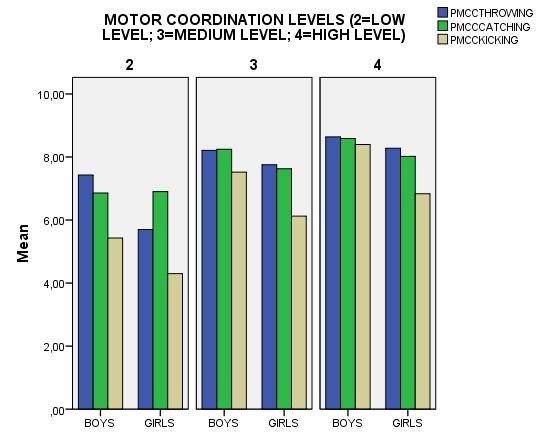
Correlation analyses
In order to analyse the existing relations between the motor coordination level of the 3SJ test and the different psychosocial variables of interest after considering the gender factor, a Pearson’s bivariate correlation analysis was carried out (Figure
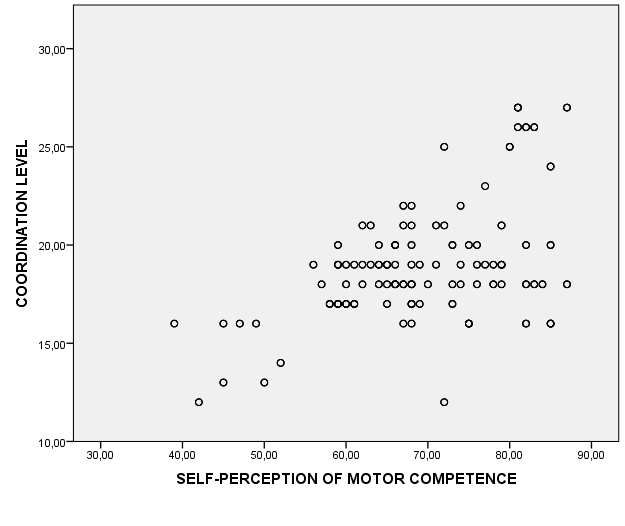
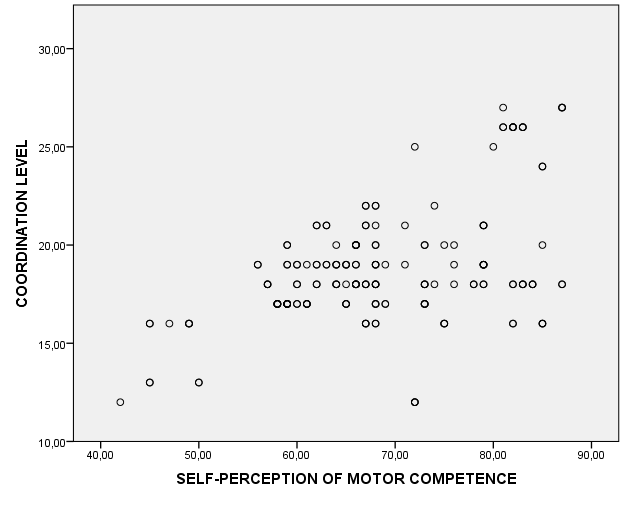
The results for the relation between motor coordination and anxiety shown in Figure
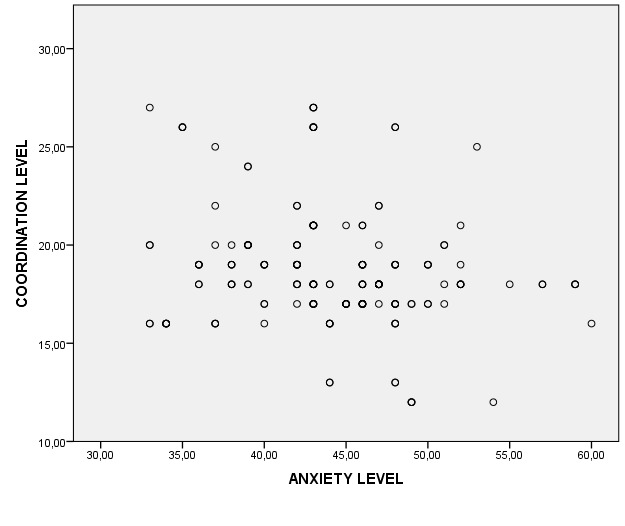
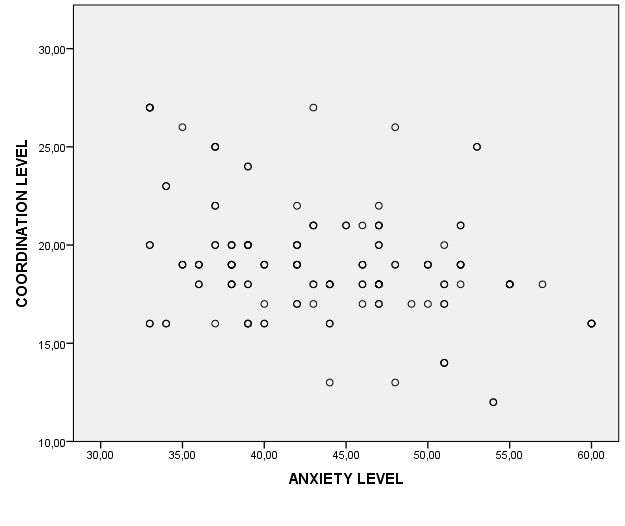
Therefore, both girls and boys presented a significant relation between motor coordination levels and the constructs self-perception of motor competence and anxiety.
The results of the relation between motor coordination and self-esteem evidenced a positive significant relation for boys (r= .28, p=.000). The same occurred for achievement motivation, whose relation with motor coordination was also significant (r= .60, p=.000). However, no significant results were obtained for the female gender for the relation linking motor competence with self-esteem and achievement motivation (Figure
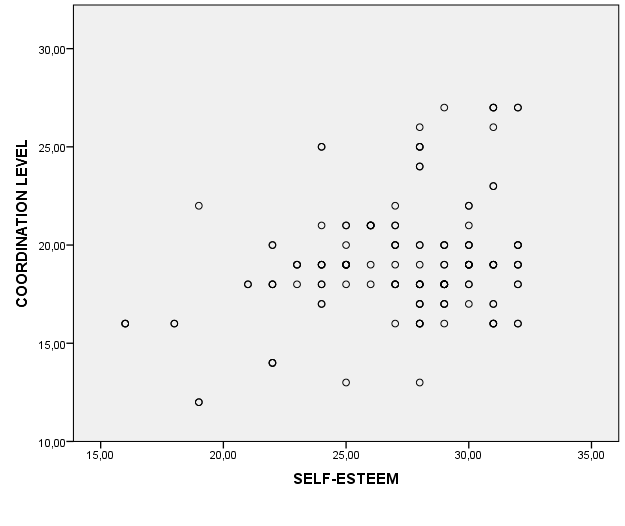
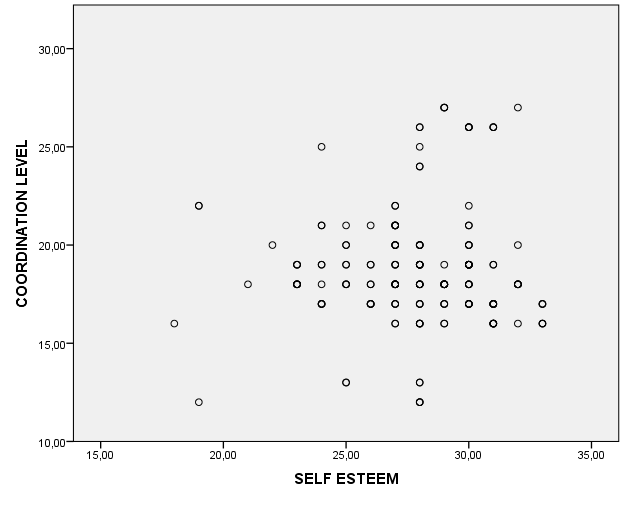
Conclusion
Motor competence development is affected by social, cognitive and psychosocial factors. Therefore, it is important to carry out a global analysis of this concept by studying the inherent relations among them.
Our results determined that motor coordination levels are influenced by factors like self-perception of motor competence and gender, and are related to other psychosocial factors. Taken together, motor coordination levels and gender had significant effects on self-perception of motor competence in terms of skill like throwing, kicking and catching moving objects.
Some relations were found between motor coordination levels, which present participants who have psychosocial factors like self-esteem and motivation in terms of engaging in learning. These relations were determined by the gender factor.
Our findings have relevant implications for knowing and understanding pupils’ progress-related development in a stage when their body structure develops, they better master their body and they establish relations with their environment. All this leads to the following implications:
First of all, it is necessary to bear in mind social and cognitive factors to study motor competence. Self-perception of motor competence in specific skills based on mastering moving elements is determined by motor coordination levels and gender has no significant effect on motor coordination levels, but determines some relations between motor competence levels and psychosocial constructs.
One of the limitations of this study is its exploratory nature as it takes initial evidence about motor competence development and the sample. One future research line would be to increase the sample size and change the nature of the study over a longer study period. This would fall in line with authors like Ruiz and Graupera (2003), who referred to the need to conduct more longitudinal studies that really and specifically show us what motor development is like in our schoolchildren, the changes that it involves and their possible causes. In addition, a mediation analysis that can better understand the concept of motor competence can be carry out.
Acknowledgments
We wish to thank all the schools, pupils and their families for participating in this study. We also thank all the teachers who intervened in this study in their own contexts.
References
- Anguera, M., Magnusson, M., & Jonsson, G. (2007). Instrumentos no estándar [Non-standard instruments]. Avances en Medición, 5(1), 63-82.
- Arruza, J. A., Arribas, S., Otaegi, O., González, O., Irazusta, S., & Ruiz, L. M. (2011). Percepción de competencia, estado de ánimo y tolerancia al estrés en jóvenes deportistas de alto rendimiento [Perception of competence, mood state and stress tolerance in young high performance athletes]. Anales de psicología, 27(2), 536-543.
- Benjumea, J. M. C., Afonso, J. R., Pineda, S. M., & Fernández-Truan, J. C.(2017). Test de coordinación motriz 3JS: Cómo valorar y analizar su ejecución. 3JS motor coordination test: How assess and analyze its execution Retos: nuevas tendencias en educación física, deporte y recreación, 32, 189-193.
- Bisquerra, R. (2004). Metodología de la investigación cuantitativa [Quantitative research methodology]. Madrid, España: La Muralla.
- Figueras, S., Capllonch, M., Blázquez, D., & Monzonís, N. (2016). Competencias básicas y educación física: estudios e investigaciones [Core Skills and Physical Education: Studies and Research]. Apunts. Educación Física y Deportes, 123, 34-43. https://doi.org/10.5672/apunts.2014-0983.es.(2016/1).123.04
- Gil, P., Contreras, O. R., & Gómez, I. (2008). Habilidades motrices en la infancia y su desarrollo desde una educación física animada [Motor skills in children and its development from an education animated physics]. Revista iberoamericana de Educación, 47, 71-96. https://doi.org/10.35362/rie470705
- González, T. (2010). La competencia motriz también existe. Reflexión [Motor competence too exists. Reflection]. Eduinnova, 25, 130-138.
- López, A., Camerino, O., & Castañer, M. (2015). Evaluar la motivación en la educación física, una aplicación con AMPET [Assessing motivation in physical education, an AMPET application]. Tándem, 47, 55-64.
- Robles, H. (2008). La coordinación y motricidad asociada a la madurez mental en niños de 4 a 8 años [Coordination and motor function associated with mental maturity in children aged from 4 to 8 years]. Avances en Psicología Latinoamericana, 16(1), 139-154.
- Ruiz, L. M. (1995). Competencia Motriz. Elementos para comprender el aprendizaje motor en educación física escolar [Motor Competente. Elements to understand motor learning in school physical education]. Madrid, España: Gymnos.
- Ruiz, L. M. (2014). De qué hablamos cuando hablamos de Competencia Motriz [What do we talk about when we talk about Motor Competence?]. Acciónmotriz, 12, 37-42.
- Ruiz, L. M., & Graupera, J. L. (2003). Competencia motriz y género en escolares españoles [Motor competence and gender between the scholastic Spanish]. Revista Internacional de Medicina y Ciencias de la Actividad Física y el Deporte, 10(3), 101-111.
- Ruiz, L. M., Moreno, J. A., Ramón-Otero, I., & Alias-García, A. (2015). Motivación de logro para aprender en educación física: adaptación de la versión española del test AMPET [Motivation of Achievement to Learn in Physical education: Adaptation of the Spanish version of AMPET test]. Revista Española de Pedagogía, 260, 157-175.
- Zwicker, J. G., Missiuna, C., Harris, S. R., & Boyd, L. A. (2012). Developmental coordination disorder: a review and update. European Journal of Paediatric Neurology, 16(6), 573-581. https://doi.org/10.1016/j.ejpn.2012.05.005
Copyright information

This work is licensed under a Creative Commons Attribution-NonCommercial-NoDerivatives 4.0 International License.
About this article
Publication Date
27 May 2020
Article Doi
eBook ISBN
978-1-80296-083-9
Publisher
European Publisher
Volume
84
Print ISBN (optional)
-
Edition Number
1st Edition
Pages
1-330
Subjects
Teacher training, bullying, child abuse, abusive relationship, neglected child, neglected teenager, cognitive psychology
Cite this article as:
Berges, M. S., & Bustamante, J. C. (2020). The Results In Vocational Training And The Personal Growth Of Teaching Students. In C. Salavera, P. Teruel, & J. L. Antoñanzas (Eds.), Observatory for Research and Innovation in Social Sciences, vol 84. European Proceedings of Social and Behavioural Sciences (pp. 200-210). European Publisher. https://doi.org/10.15405/epsbs.2020.05.21
